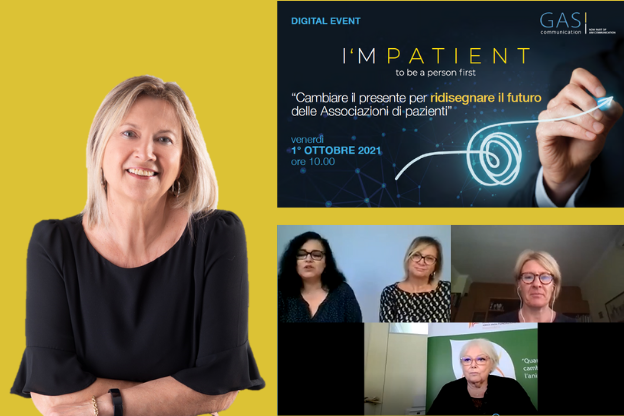
I’M Patient: the Vademecum for Patient Associations in the time of the pandemic.
From the discussion that emerged during the first I’MPATIENT event dedicated to Patient Associations, organised by GAS Communication, the top priority actions to be effective.
A handbook dedicated to patient associations explored all the useful aspects for a relaunch strategy to foster synergy with institutions, companies, volunteers, patients and citizens. The document is the result of the online event Changing the present to redesign the future, the first in the series of I’MPATIENT meetings organised and promoted by GAS Communication, a Media Relations and PR agency specialising in health communication, part of AIM Communication.
The discussion of patient associations involved representatives of all relevant stakeholders including experts in communication, fundraising, Public Affairs, representatives of scientific societies and pharmaceutical companies, politicians, representatives of institutions as well as the media and social media.
During the Covid-19 Pandemic, Patient Associations played a crucial role, giving practical and immediate responses to the needs emerging from the patient community, increasing communication channels, mobilising human and economic resources, strengthening practical and psychological support.
To relaunch and strengthen their action in the current social and health context, some best practices and recommendations have emerged that are summarised in a Vademecum, published on the GAS website and sent to all associations invited to the event. Here, in summary, are the top priority actions that patient associations should promote to be effective, divided into macro-areas referring to their main stakeholders:
THE VALUE OF MEDICAL-PATIENT COLLABORATION WITH SCIENTIFIC SOCIETIES:
- Support, through active collaboration, educational projects for healthcare personnel, who are not always up-to-date on all the needs of patients.
- Promote integrated assistance and not limited to medical services, including the bureaucratic, legal, social, psychological aspects on which doctors are not up to date.
- Supporting research: Patient Associations have the ability to raise funds for scientific studies, which scientific societies can channel into research.
AN EQUAL COLLABORATION WITH PHARMACEUTICAL COMPANIES:
- Increase the level of representation: a federation or a union between several Associations can increase the specific weight and interests to be shared with pharmaceutical companies.
- Playing as equals: promoting a path of managerial growth within the Associations that facilitates dialogue with companies.
- Claim the mutual obligation of transparency. To avoid possible conflicts of interest, it may be useful to establish roles also with a written contract or Consensus Paper.
THE POSSIBLE SYNERGY BETWEEN PATIENTS, POLITICS AND INSTITUTIONS:
- Develop advocacy activities, to actively participate in the decision-making and legislative process, with the support of documented data and knowledge, useful for institutions.
- Promote the highly qualified training of expert patients. With their knowledge, reliability, skills and experience, expert patients are at the service of the community and can more easily contribute to the legislative processes and to the research, testing and development of drugs for their pathology.
- Take advantage of digital communication channels, such as webinars, video conferences, video testimonials, which allow for a faster and more effective dialogue with institutions.
COMMUNICATION, MEDIA AND SOCIAL MEDIA: THE INFORMED PATIENT
- Support journalists in disseminating health issues. Develop a constant dialogue with the media, also thanks to a structured press office, and know how to offer information from scientifically reliable sources, supported by data and statistics, but also stories of people, care and patients. Collaborate in the fight against fake news that often impacts patients.
- Build the association digital identity, a necessary condition for an effective presence on the web and on social media, which starts from a clear communication strategy, related to identity, history, objectives of the association and consistently translated into the mix of channels and tools.
“The lively and in-depth debate offered by the many experts who attended the webinar, belonging to associations as well as companies, institutions and the media, offered many useful ideas that, as the participants reported in the feedback, should be further explored” notes Giuliana Goggi, CEO of Gas Communication. “This first event of a series dedicated to patient associations has therefore confirmed the idea that it is really useful to encourage dialogue between all stakeholders to promote an overall growth of the system around the patient.”

